Version 0172
- Release summary
- Important information
- Quinyx web app Version 0172
Release date November 1, 2023
Release summaryShort on time and want a high-level summary? Quinyx web app Version 0172 New functionality
Updates and performance improvements
Bug fixes
Important information
Frontline Portal Version 0172 New functionality
Bug fixes
SOAP API / Webservice updates
|
Important information
End of life of the Classic and mobile SSO by March 31, 2024
Quinyx has decided that the support for the old SSO configuration (Classic and Mobile) will be removed during 2024.
New configurations are already available in the Manager Portal, and you'll now only need one configuration for all Quinyx applications. We recommend that customers who are still using the old configuration start planning for setting up the new configuration.
The new configuration provider setup supports either SAML 2 or OPEN ID standards.
- General information: SSO basics
- Azure: SAML single sign on and OPEN ID single sign on
End of life of the Notice of Interest functionality December 2023
Our legacy functionality, Notice of Interest, will be discontinued at the end of December 2023. Therefore, we urge all our customers to use the Availability functionality instead of Notice of Interest as soon as possible. The availability functionality is more user-friendly and supports more use cases than the Notice of Interest functionality.
One function that availability supports is converting an availability item into a shift in the Schedule view of the Quinyx web app. Quinyx also supports sections with availability and multi-selection of both units and sections when creating availability as a user. We've implemented the possibility for users to see, create, edit, and delete their own availability hours in our mobile apps.
Quinyx web app Version 0172
Release date November 1, 2023
New functionality
Sharing bank holiday functionality
To improve the overall user experience around Bank Holidays and reduce the amount of manual work needed to effectively manage them, with this release, we’re happy to introduce the new sharing action.
Where, as detailed below, we’ve added this new share behavior to two touch-points in the application:
- The first is in Global Bank Holidays, where you can now share your configurations across available bank holidays to allow for easier management and curation of the configurations.
- The second is in Agreement Templates, where you can now copy and share bank holidays you’ve created across agreement templates.
Sharing configurations across bank holidays
When you're managing global bank holidays, there is often a lot of manual work required to fully configure each and every bank holiday within a given year. This can be frustrating to do, as in many cases, holidays have a common set of “standard” configurations for a given year - meaning it’s a lot of repetitive work to manually add every configuration to every bank holiday again and again.
To improve that experience - we’ve added the new Share Action. Where using Actions > Share to holidays, you can now easily take the configurations from one holiday and magically share those configurations to any other holiday within that same year.
And so, with a few clicks, you can now easily share your “standard” bank holiday rules to all holidays and then just make the required tweaks to any holiday which may require some special outlier configurations.
- Select the source holiday that you’d like to share configurations from.
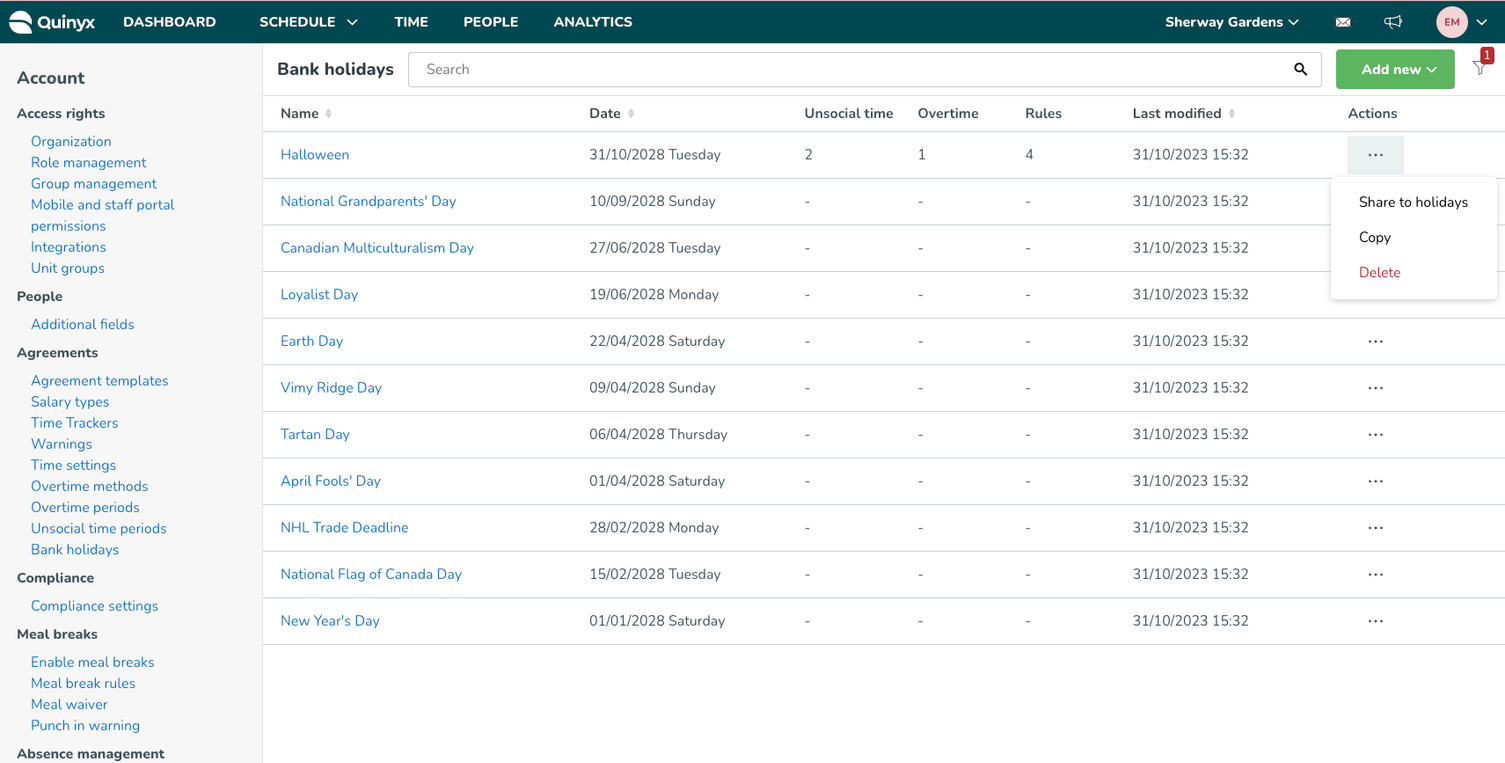
- Select which bank holidays (within the same year) that you’d like to share the configurations to.
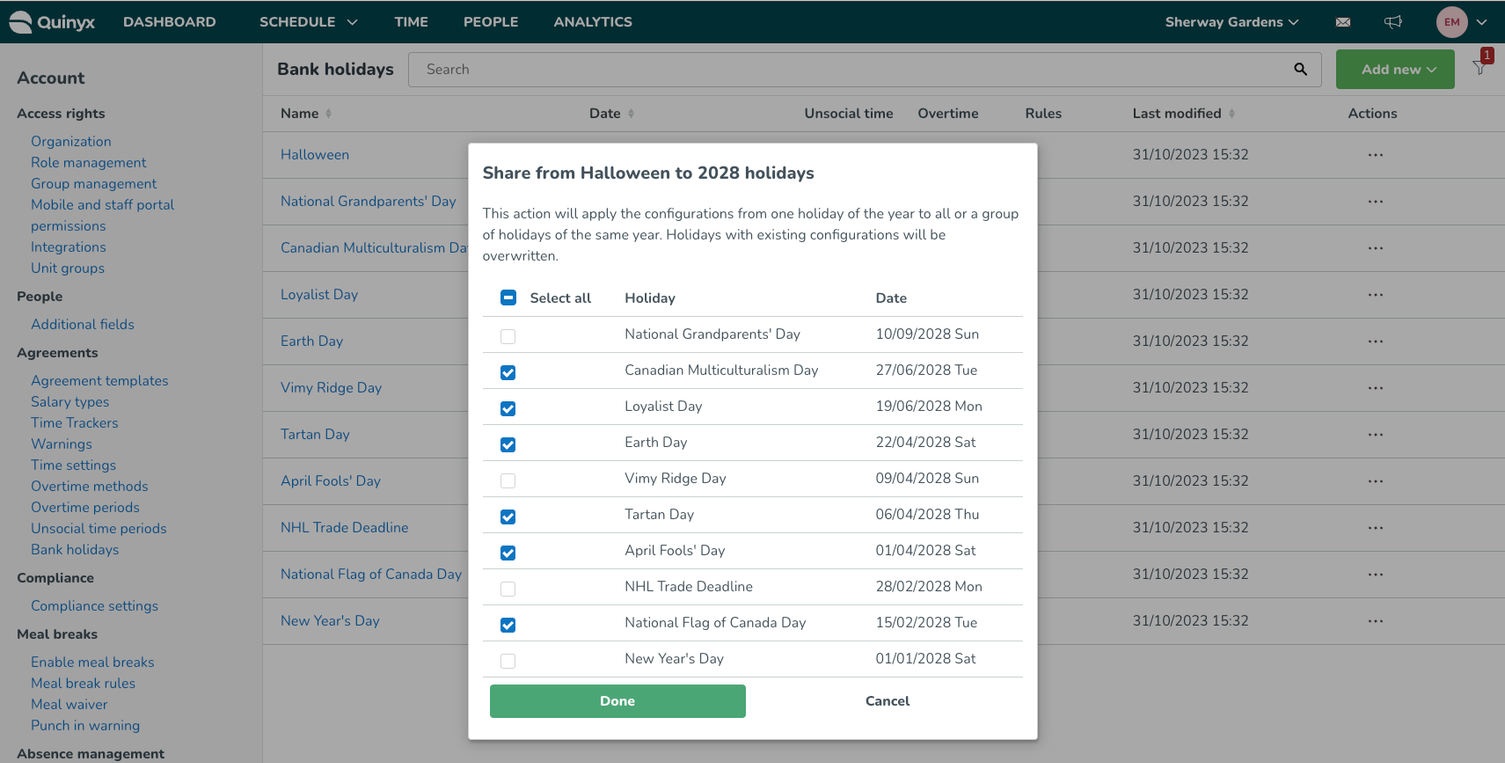
- Once done, all configurations (except Name and Date) will be copied to all the selected holidays!
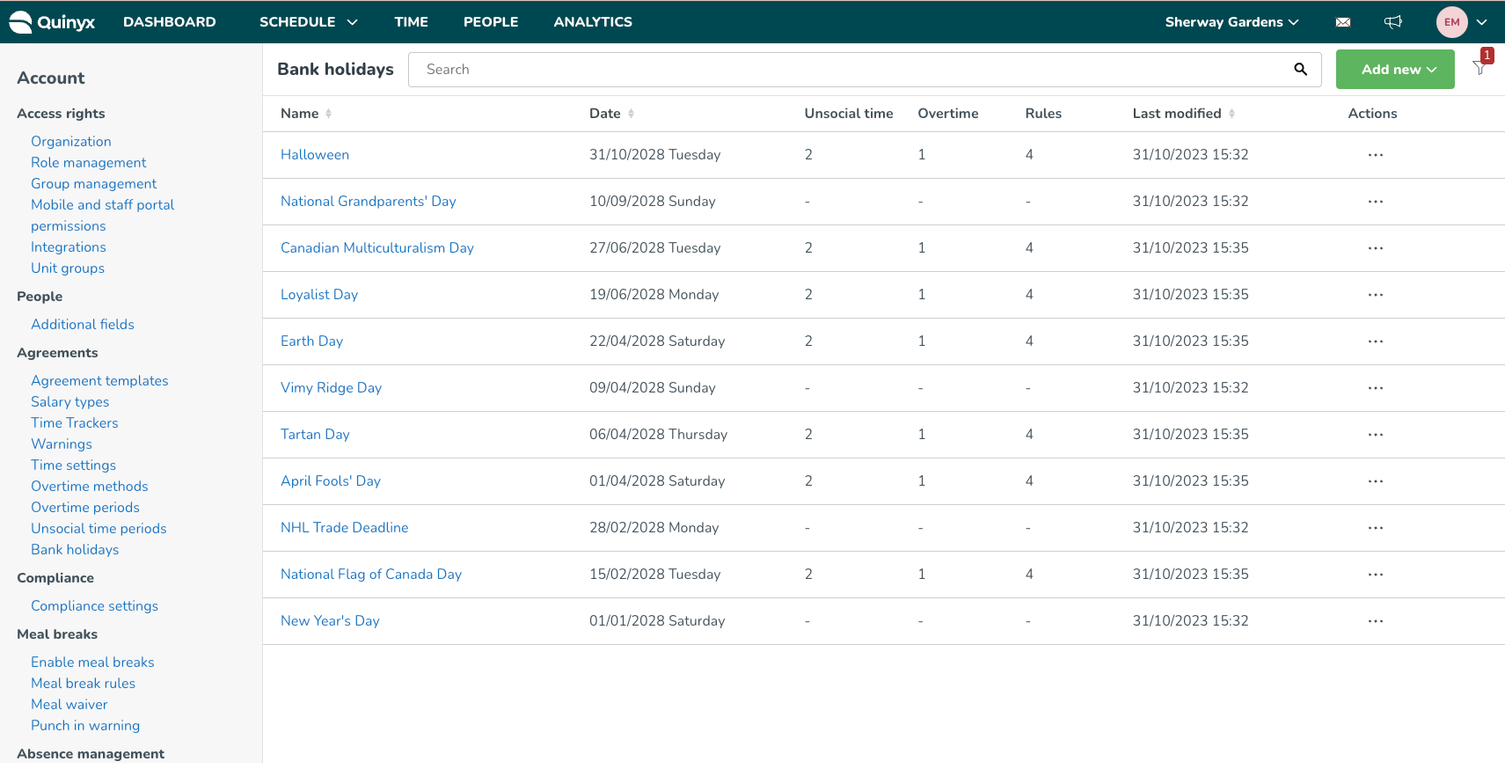
Sharing bank holidays across agreement templates
Likewise, there is a lot of manual work required to effectively manage bank holidays within agreement templates. And - like in the example above - this can be frustrating as, in many cases, it is the same bank holiday configurations required in each agreement template, thus introducing a lot of repetitive work.
To alleviate this, we’ve introduced this same sharing logic to agreement templates. Now, when configuring an agreement template, you can simply select another agreement template which you’d like to copy bank holidays from, and they will automatically be shared to your new agreement template to make this management of bank holidays quicker and easier.
- De-select the Use default bank holidays checkbox to allow the use of custom holidays.
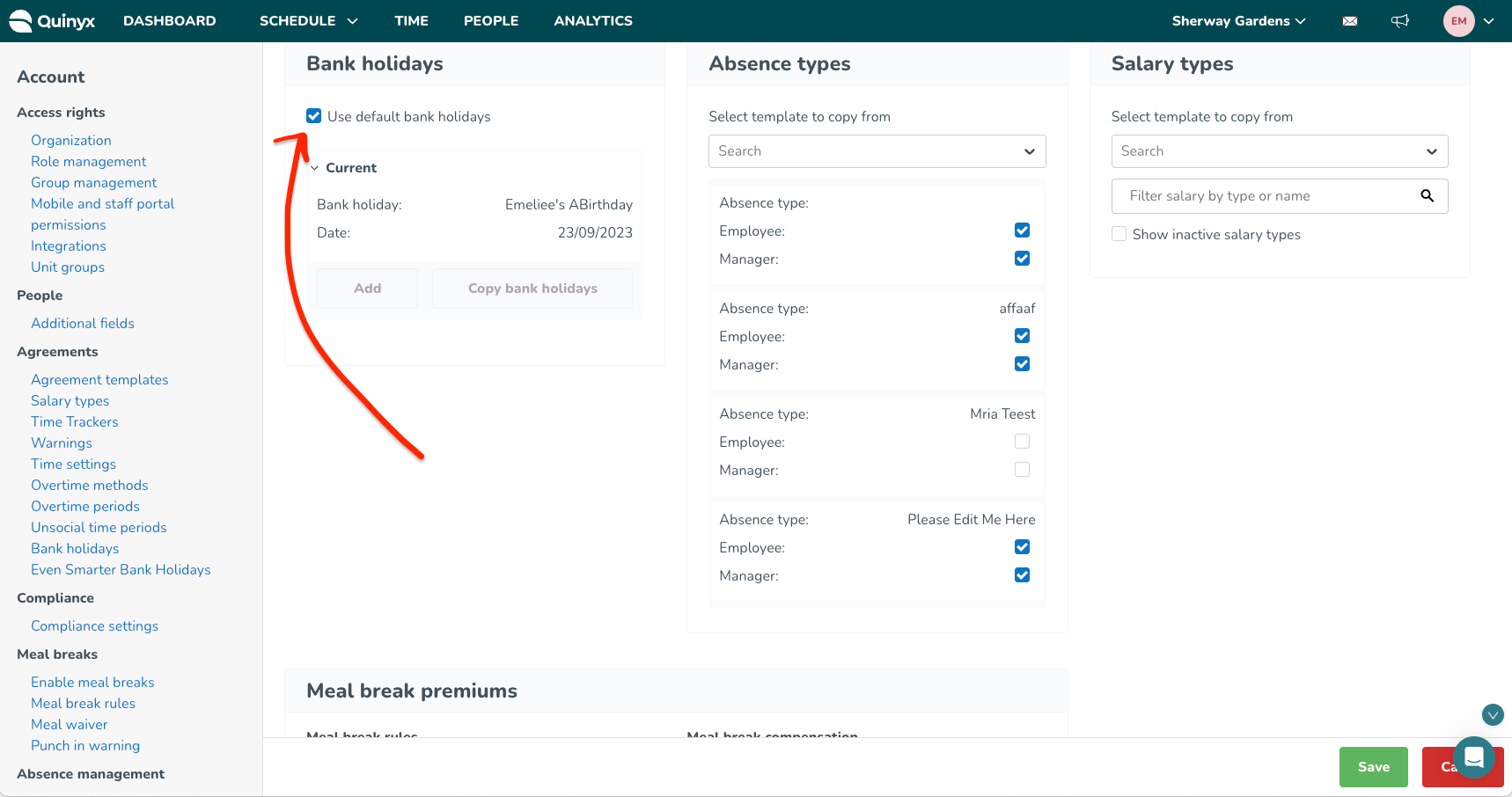
- Select which agreement template you want to copy existing Bank Holidays from.
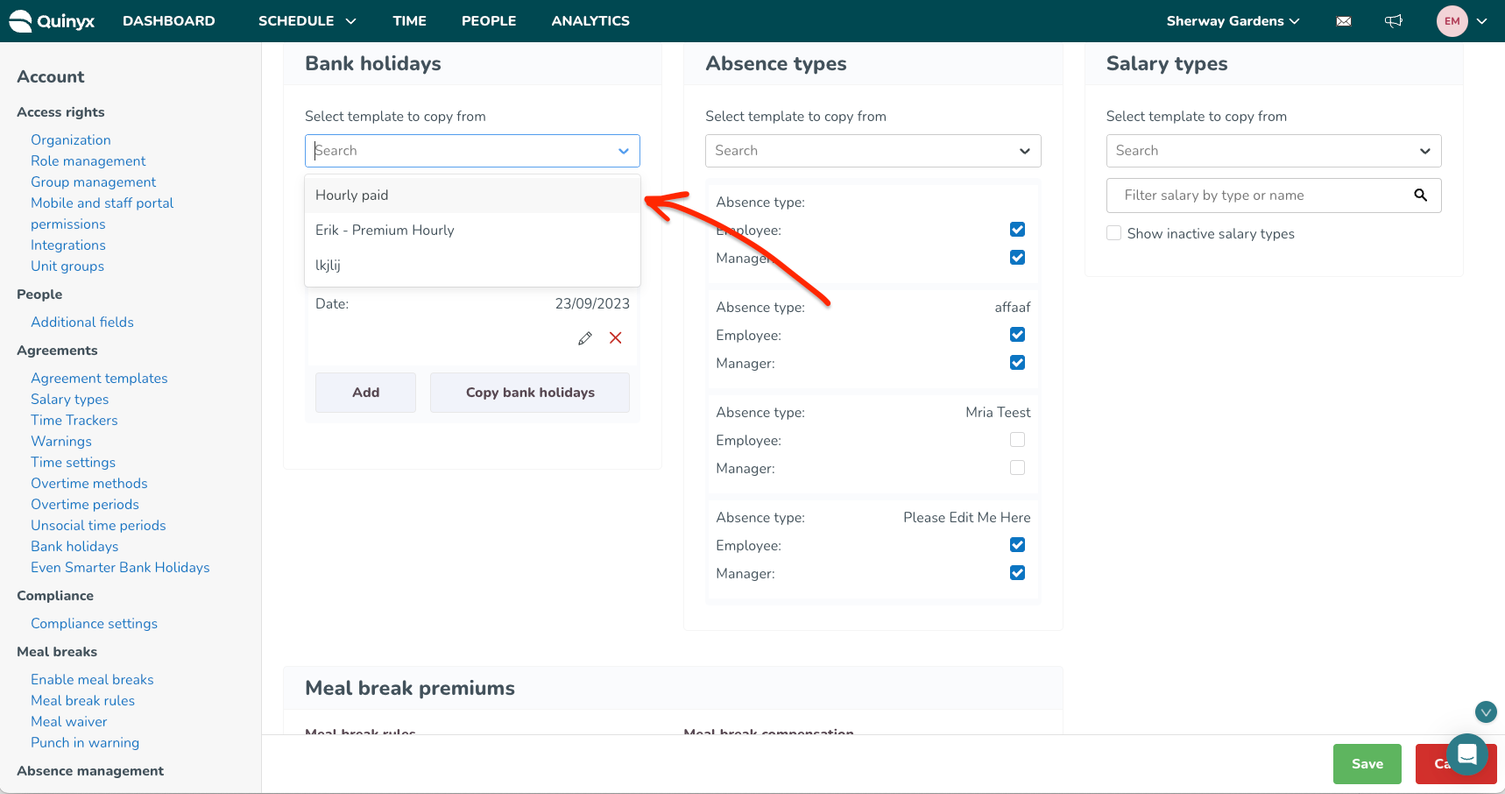
- Select which holidays you’d like to copy (if there are any conflicts, this will be flagged so you don’t overwrite anything accidentally).
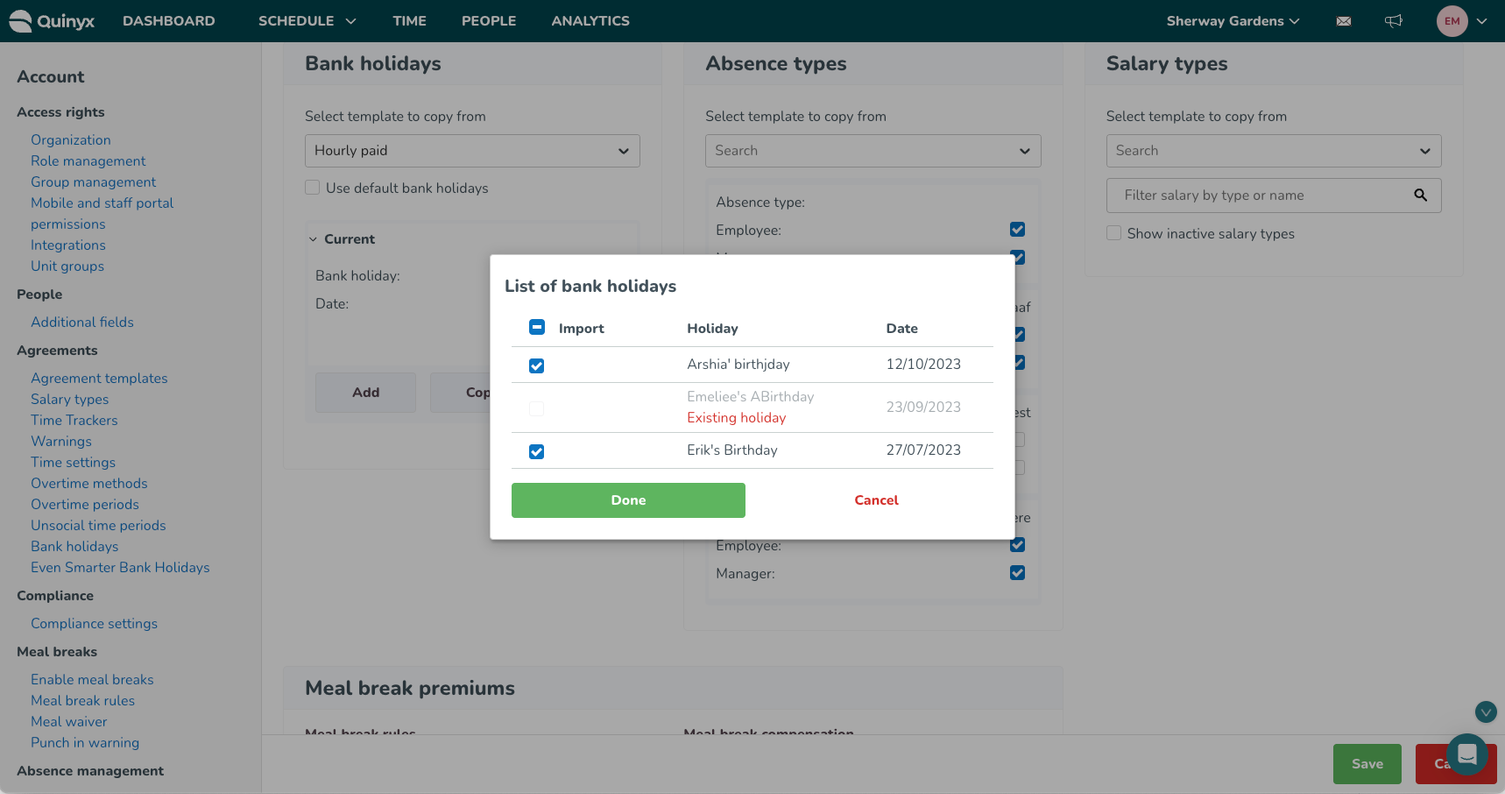
- Done! Hit the green Save button at the bottom to save the changes to your agreement template.

Minimum and Maximum constraints on Optimal Headcount
We have added an additional labor rule to the new Optimal Headcount & Labor Standards functionality: minimum and maximum rules.
What are minimum and maximum rules?
Minimum and maximum rules are constraints that can be configured for your Optimal Headcount to indicate the minimum or maximum headcount needed for that specific role/shift type. For example, you need to ensure that at least 1 manager is scheduled at all times. Or you can never schedule more than 6 cashiers at the same time, although demand might require it, because of physical constraints of the unit.
Minimum and maximum rules can be used for informative purposes when doing manual scheduling, or to constrain the Auto Schedule to ensure that the resulting schedule does not exceed the set minimum or maximum requirements.
How can I use minimum and maximum rules?
Minimum and maximum rules can be set up within the labor standards within your optimal headcount variables (this is only applicable when using the new Optimal Headcount & Labor Standards functionality, read more about it here: Optimal Headcount and Labor Standards NEW.
Minimum and maximum rules can be configured per day of the week and time of day. It is also possible to connect the minimum and maximum rules to your opening hours, e.g. you need a minimum of 1 manager 15 minutes before opening hours to 15 minutes after opening hours. Read more about how to set up your opening hours here: Opening hours - standard and special hours.
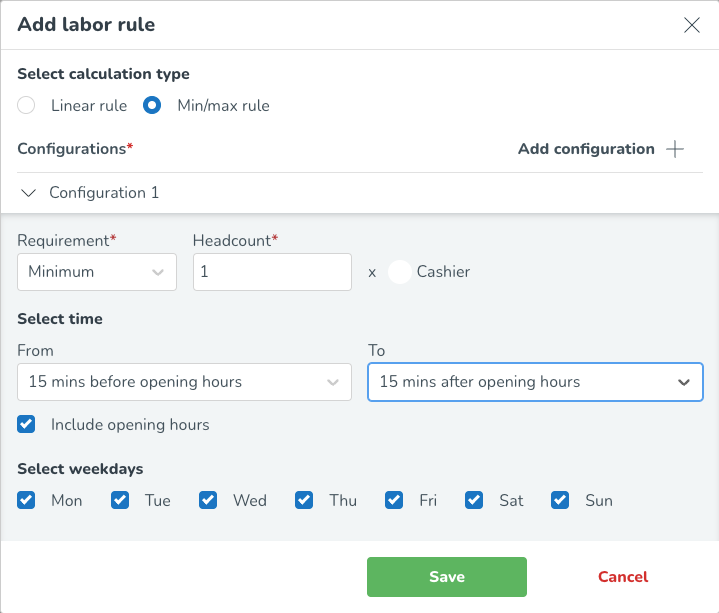
What’s next?
We'll continue developing additional ways of defining labor needs to allow for more extensive labor standard definitions. This includes migrating over functionalities from current static and dynamic rules and being able to visualize your minimum and maximum constraints in schedule statistics. Additionally, we want to make sure that these inputs can be used in Auto Schedule. Please stay tuned!
What do I need to do if I am currently using Labour Standard Calculations in Pythia to define my labor needs and minimum/maximum constraints?
If you are using Auto Schedule to create your schedules, you'll need to wait until the algorithm can consider these new optimal headcount values as input to properly use this functionality. Until then, you can configure your labor needs and minimum and maximum constraints in Quinyx, but they will not yet be accounted for within our Auto Schedule solution. Please stay tuned for when and how this will be possible.
Updates and performance improvements
Improvements to Time Tracker accrual drivers
With this release, we are adding some further clarity improvements to the following Time Tracker accrual drivers relating to absences:
- Each vacation leave day
- Each vacation leave hour
- Each absence type leave day
- Each absence type leave hour
When selecting any of these accrual drivers in the Edit Time Tracker association menu (Account settings > Agreement > Agreement templates > Time Trackers), you are today met with these three radio button options: No reduction, Reduction of Saturdays, and Don't accrue on selected days of the week.
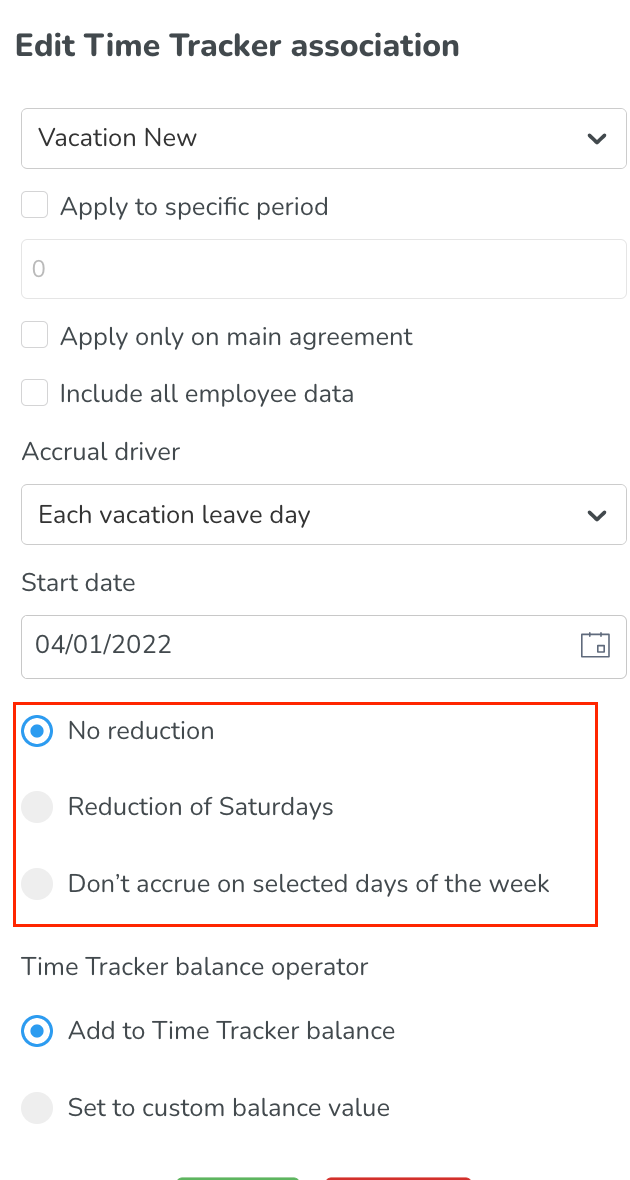
Over the past releases, we have discovered that there was room for improvement in terms of explaining what these options actually do. As such, we have updated the naming of these options to better reflect their functionality, as well as added further explanatory text beneath each of them.
When using any of these Time Tracker accrual drivers going forward, the radio buttons belonging to them will instead be named the following, along with the explanatory text below:
- Adjust balance based on absence shifts (previously named No reduction): Adjusts the balance on any weekday, but only does so if there's an absence shift on said day.
- Always adjust Saturdays (previously named Reduction of Saturdays): Adjusts the balance on Saturdays regardless of whether there's an absence shift or not, but for remaining weekdays, the balance is only adjusted when there's an absence shift.
- Always adjust with exceptions (previously named Don't accrue on selected days of the week): Adjusts the balance regardless of whether there's an absence shift or not, except for the weekdays selected in the below field, which are never adjusted.
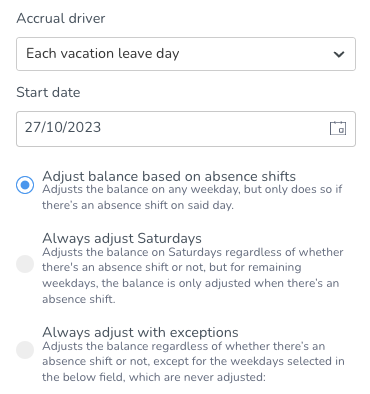
New timeframe options for Oauth token settings
When configuring Global Account Settings > Oauth token settings, you can now also select 30 minutes from the dropdown.
Performance improvements to the search function in the People tab
To improve the performance and load times experienced when performing a search in the People Tab a user must hit “Enter” after typing in the name, or whichever criteria they’d like, to initiate the search.
Bug fixes
- Resolved an issue causing different behavior between absence types created in Classic vs Quinyx when absence reason affects buffer days was unticked.
- Resolved an issue in the UI for Events that caused the Delete button to be displayed as Restore.
New Quinyx HelpDocs content
New HelpDocs articles
New tutorials
- None at this time.
Frontline Portal Version 0172
Release date November 1, 2023
New functionality
Widgets
We're happy to announce the release of widget functionality.
IMPORTANT!
When using this functionality, we recommend limiting access to this powerful functionality to a select group of HQ users, as it grants the ability to shape the layout of the entire site. By restricting the number of individuals with this permission, you can ensure a secure and controlled environment to prevent issues that might arise if multiple content managers are using widgets concurrently.
If you require further information or have specific queries about these features, please do not hesitate to get in touch with your dedicated Customer Support Manager. Your CSM can offer personalized guidance on optimizing widget usage.
You can't grant permission to widgets to users yourself. If you're a Quinyx support contact, please reach out to our Support team. They can help you get started.
Using widgets
You can use Frontline Portal's new widget functionality to group different resource types, target bespoke combinations of the most relevant content for your needs, and drive engagement.
Widgets aren’t just about aesthetics; they enhance efficiency and user engagement. By reducing the time spent searching for information, widgets enable users to focus on tasks and goals, and you can better address prioritization needs and have more control and ownership over pages' look and feel.
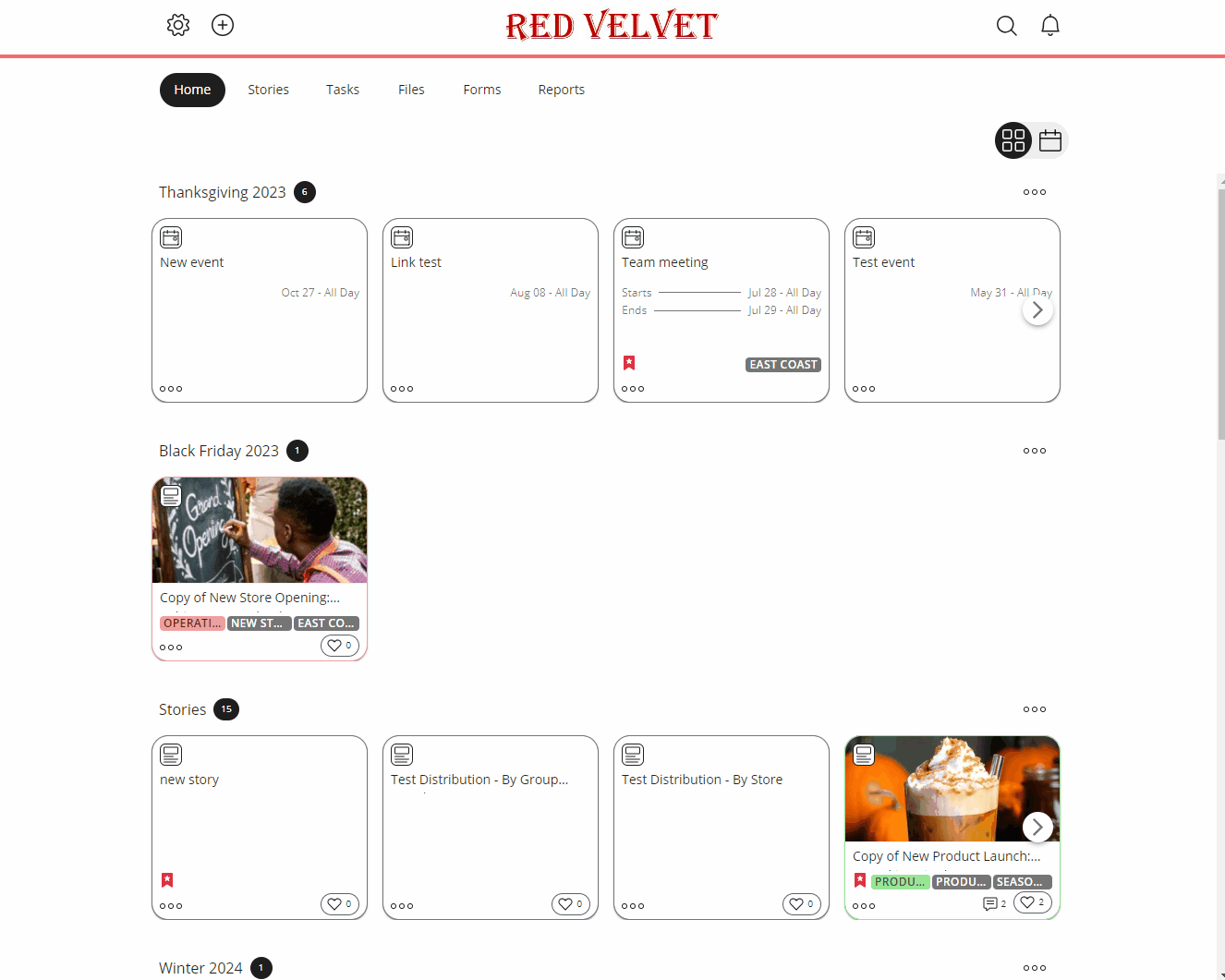
Bug fixes
- None at this time.
New Frontline Portal HelpDocs content
SOAP API / Webservice updates
- No updates in this release.
- No endpoints are currently deprecated and planned for removal.Click here to view the new Quinyx WFM Web Service documentation. You can find even more web services info here.We encourage all of our customers to make use of our APIs to maintain data and to make sure that information is up-to-date. To ensure the scalability of our APIs while growing our customer and user base, we've decided to add restrictions on the usage of our SOAP APIs. These restrictions will be enforced programmatically, which means we will enforce a limit on concurrent calls per customer to 10. You should expect response code 429 if you happen to exceed this limit, and you are recommended to implement a backoff retry mechanism to handle the limit. Note that the limit applies to SOAP only. When moving from SOAP to Rest over the coming years, any limits will be built into the API.
Please make sure to forward this information to the party within your company responsible for integrations.

